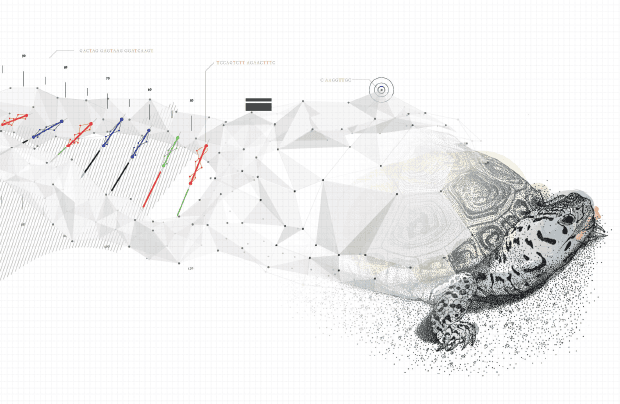What Makes Terrapins Tick
Faculty and Freshmen Sequence Mascot’s DNA
by Chris Carroll | illustration by Jesse Wu ’14 What makes a diamondback terrapin, UMD’s mascot and Maryland’s state reptile, cry salty tears? No, not a second-round loss in the NCAA tournament—it’s the water they inhabit. Terrapins evolved in freshwater and moved into brackish water like that of the Chesapeake Bay, and they use tear ducts to clear excess salt from their bodies. How they developed that ability and others that suit them for saline water is anybody’s guess, however, and it’s just one of the intriguing questions animating a project at UMD to fully sequence the diamondback terrapin’s genome for the first time. The result will be a genetic blueprint of one member of the species, a female captured on Poplar Island that researchers dubbed Testuda. “Terrapins are very poorly studied overall,” says Mihai Pop, an associate computer science professor with the Center for Bioinformatics and Computational Biology (CBCB). “There are few genome sequences from turtles, and yet they are very important from an evolutionary viewpoint.” They’re turning out to be an important animal for Maryland freshmen eager to dive into serious science. The terrapin genome project is one of nearly a dozen research groups students can join in the First-year Innovation & Research Experience (FIRE) program. After basic sequencing aimed at producing a rare, nearly complete “gold-standard” genome, students will begin projects analyzing small parts of the whole this fall, says Stephen Mount, associate professor of cell biology and molecular genetics in CBCB. “They’ll become experts in particular gene families,” he says. “Someone could be an expert in myosin proteins, which are important in muscle contractions. Someone else could study sodium pumps on the cell surface … [and] desalination.” The diamondback terrapin DNA project is a chance for the university to both show off its cutting-edge genome assembly expertise and light a fire under young students by plunging them early into serious research. “They’re not giving us busywork,” says Ryan Mitchell ’18. “The best thing about FIRE is that even though you may be a freshman, everyone here is contributing to the actual research.”0 Comments
Leave a Reply
* indicates a required field

